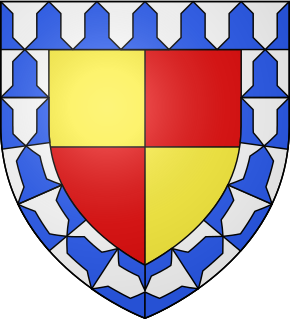
Hugh d'Avranches, nicknamed le Gros or Lupus, was from 1071 the second Norman Earl of Chester. and one of the great magnates of early Norman England.

Baron Saye and Sele is a title in the Peerage of England held by the Twisleton-Wykeham-Fiennes family. The title dates to 1447 but it was recreated in 1603. Confusion over the details of the 15th-century title has led to conflicting order for titleholders; authorities such as Burke's Peerage and Debrett's Peerage do not agree on whether or not the 1447 creation is still extant.
Geoffrey Fitz Peter, Earl of Essex was a prominent member of the government of England during the reigns of Richard I and John. The patronymic is sometimes rendered Fitz Piers, for he was the son of Piers de Lutegareshale, a forester of Ludgershall & Maud de Manderville.
Hugh Bigod was Justiciar of England from 1258 to 1260. He was a younger son of Hugh Bigod, 3rd Earl of Norfolk.
Aubrey de Vere — also known as "Alberic[us] de Ver" and "Albericus regis camerarius" — was the second of that name in England after the Norman Conquest, being the eldest surviving son of Aubrey de Vere and his wife Beatrice.

Walter de Burgh, 1st Earl of Ulster, 2nd Lord of Connaught, also spelt Bourke or Burke, was an Irish peer from the House of Burke.
Hugh de Puiset was a medieval Bishop of Durham and Chief Justiciar of England under King Richard I. He was the nephew of King Stephen of England and Henry of Blois, who both assisted Hugh's ecclesiastical career. He held the office of treasurer of York for a number of years, which led him into conflict with Henry Murdac, Archbishop of York. In 1153, Hugh was elected bishop of Durham despite the opposition of Murdac.
John Comyn (Cumyn) was Lord of Badenoch in Scotland. He was Justiciar of Galloway in 1258. He held lands in Nithsdale and Tynedale.

Walter de Lacy was lord of Meath in Ireland. He was also a substantial land owner in Weobley, Herefordshire, in Ludlow, Shropshire, in Ewyas Lacy in the Welsh Marches, and several lands in Normandy. He was the eldest son of Hugh de Lacy, a leading Cambro-Norman baron in the Norman invasion of Ireland, and Rohese of Monmouth.
George Seton, 2nd Lord Seton, of Seton, East Lothian, was a Lord of Parliament, Lord Auditor, and a Scottish ambassador.

John FitzGeoffrey, Lord of Shere and Justiciar of Ireland was an English nobleman.
Events from the 1180s in England.

Simon Fleming is the first Baron Slane whose holding of the title can be conclusively established.

Baron Lucy is a title that has been created four times, three times by tenure and once by writ, which means that the peerages could descend through both male and female lines. The first creation by tenure came in the 12th century with Chief Justiciar Richard de Luci. In 1320, the title Baron Lucy was created in the Peerage of England by writ of summons dated 15 May 1320. The title Baron Lucy has been dormant since 1398.
Richard Basset was a royal judge and sheriff during the reign of King Henry I of England. His father was also a royal justice. In about 1122 Basset married the eventual heiress of another justice; the marriage settlement has survived. In 1129–30 Basset was co-sheriff of eleven counties. Basset and his wife founded a monastic house in 1125 from their lands, which before the donation were equivalent to 15 knight's fees.
Edmund de Stafford, 1st Baron Stafford (1272/3-1308), was the son of Nicholas de Stafford, who was summoned to parliament by writ on 6 February 1299 by King Edward I.
Geoffrey Ridel was a landholder and royal justice during the reign of King Henry I of England.
William Basset was an Anglo-Norman administrator and justice.

Members of the Basset family were amongst the early Norman settlers in the Kingdom of England. It is currently one of the few ancient English families that has survived through the centuries in the paternal line. They originated at Montreuil-au-Houlme in the Duchy of Normandy.

de Valognes is a family name of two distinct powerful families with notable descendants in the centuries immediately following the Norman Conquest. Although a connection between them has been inferred by some authorities, this is not supported by positive evidence.









